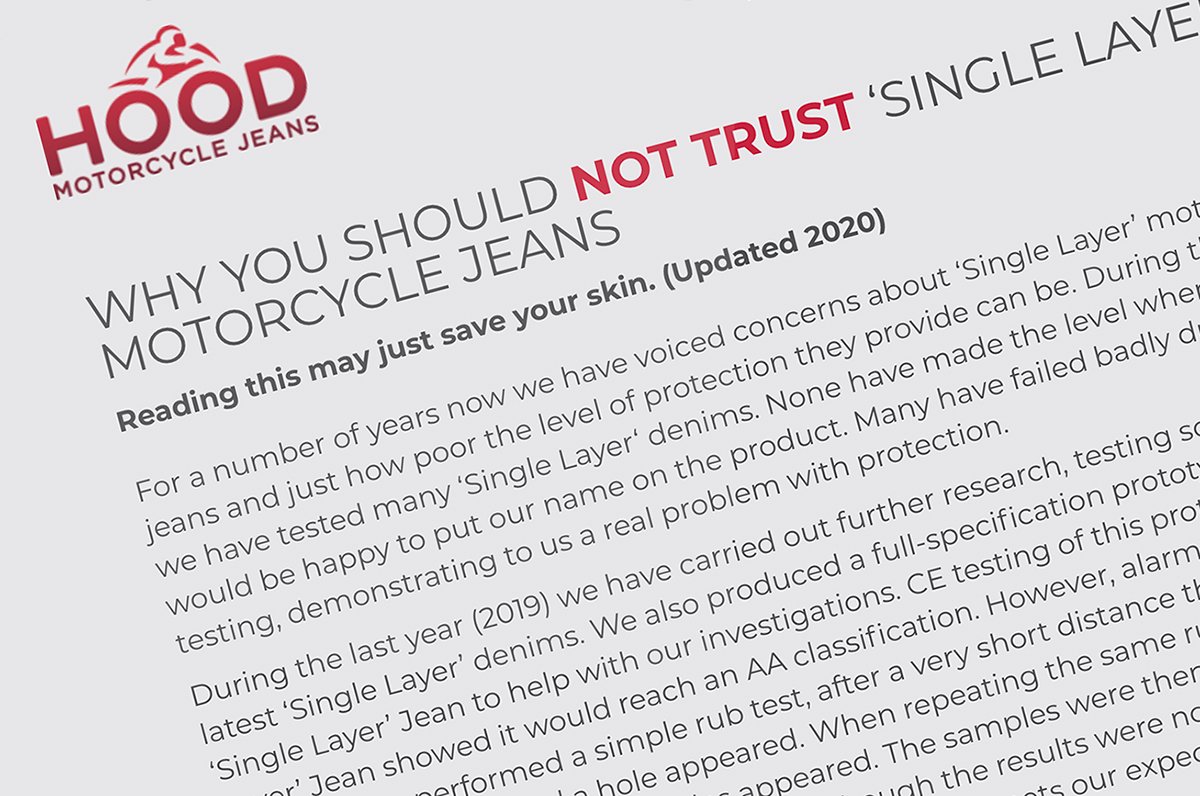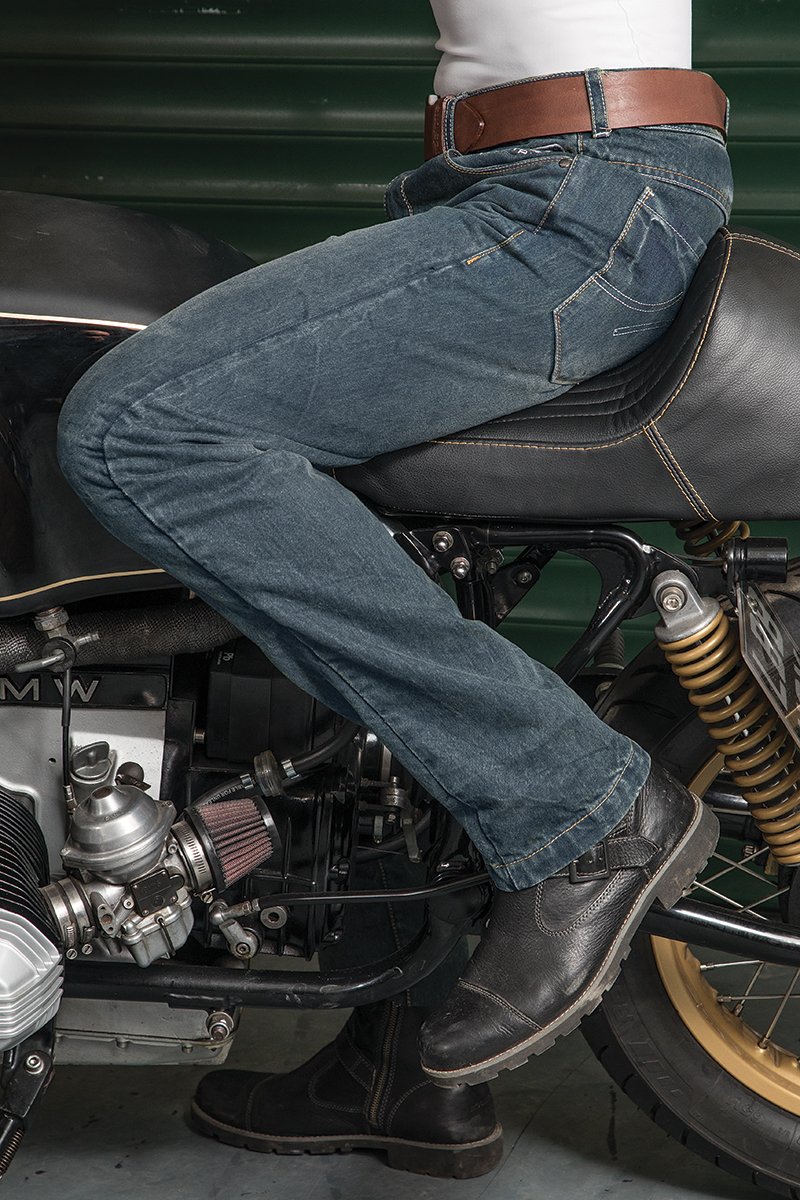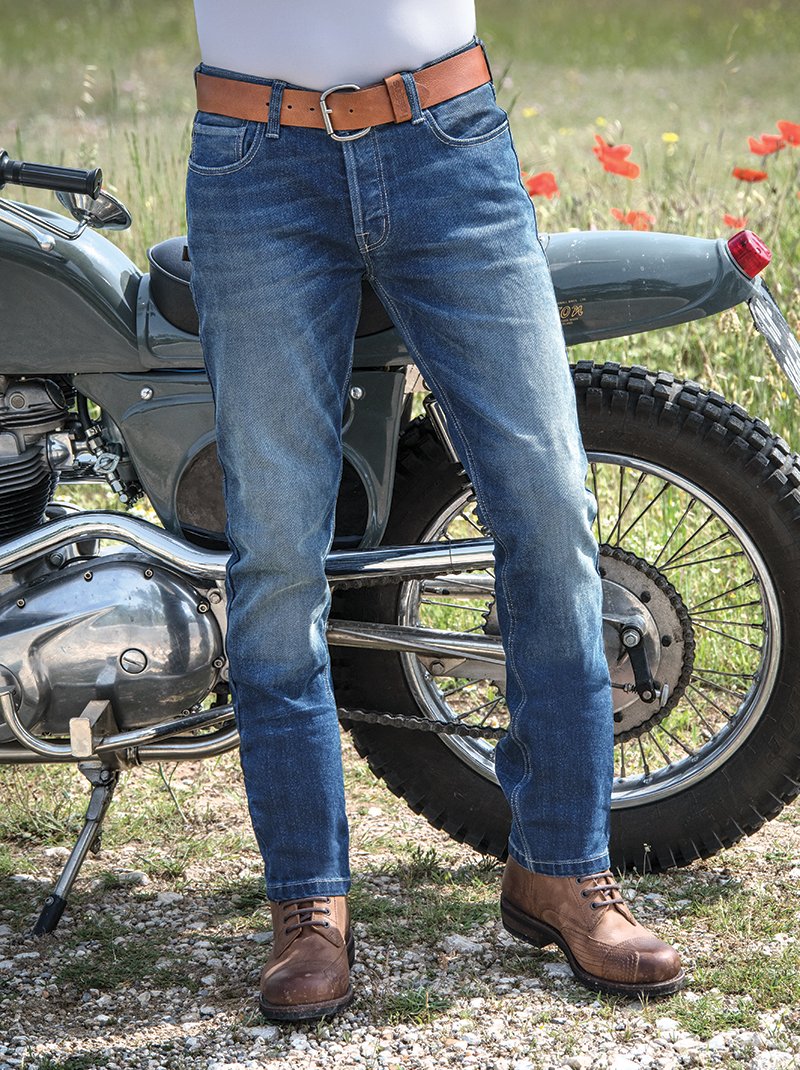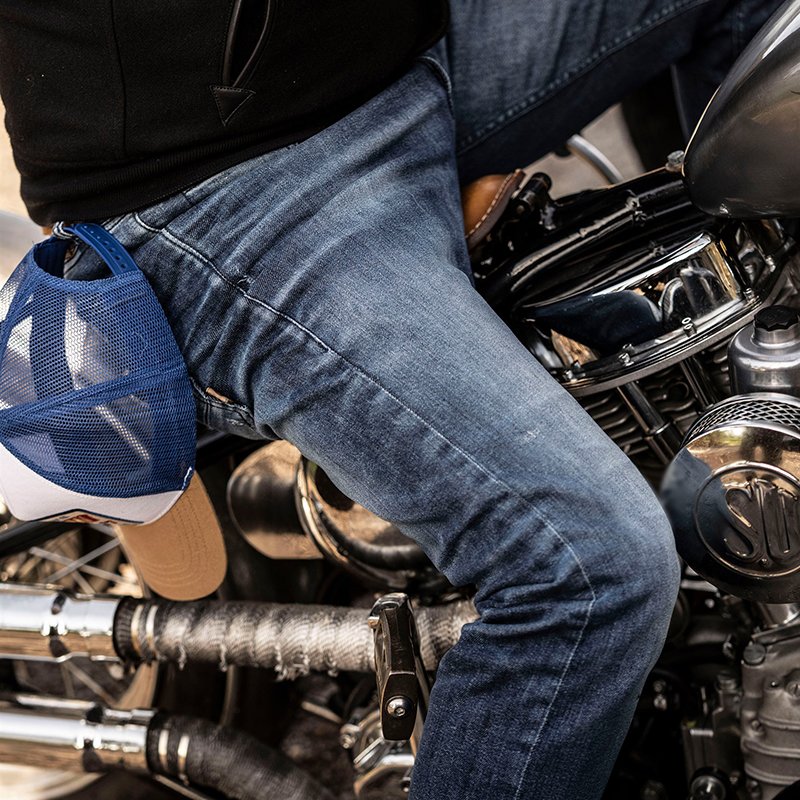Hood Jeans and why you should not trust Hood Motorcycle Jeans
Published on: 26 February 2020

Let me kick off by stating that we at Motolegends are not saying that you shouldn’t trust a pair of Hood motorcycle jeans. What we are suggesting is that you should not trust the nonsense that the Hood Jeans people have posted on the internet about single-layer jeans.
As a company, they make, from what I can see, just two types of jean. A very basic jean, accredited under EN17092 to the very lowest B classification. A ‘B’ rated jean is basically an ‘A’ rated jean supplied without armour. The A rating is the lowest of the three ratings under the new CE legislation. It is designed as a standard suitable for garments that would be worn only at low speeds in an urban environment. The company also produces an AA rated jean. Now this is a more protective standard but, in today’s jeans market, AA is nothing particularly special. There are many motorcycle jeans out there, and quite a few of them are single-layer jeans, that achieve the highest AAA rating.

Now, as a relatively small company that only makes traditional, Kevlar-lined jeans, a company that relies solely on this form of construction for all of its income, it is perhaps not all that surprising that Hood Jeans should attempt to convince the world that the method of construction it employs is the best. But the truth is that Kevlar jeans are very simple and very cheap to produce. Anyone can make them, and this is one of the reasons why lined jeans have become so popular. By contrast, the technology involved with single-layer jeans is pretty sophisticated. It is not easily accessible. A company has to have deep pockets, and the ability to sell in large volumes, in order to afford and justify the large minimum fabric quantities that are demanded by the companies that produce these fabrics. But the article they have posted on the internet about single-layer jeans is a preposterously misleading concoction of half truths, untruths, scientific-sounding mumbo jumbo, ignorance and just pure and simple bull.
Hood Jeans talk about their own experience with, and testing of, single-layer jeans, as though their testing methodology has some form of authority or credibility. There are only two meaningful measures of the protective qualities of motorcycle wear. The outgoing EN13595 test and the newer EN17092 test. But Hood Jeans imply that they have their own test regime. If this is the case, and I suspect that it does not really exist in any substantive way, then it has certainly not been independently verified, or established as being either meaningful, robust or reliable.
They talk in their article about a ‘rub’ test, for example, but nowhere in the protective wear industry does such a test exist. It is also stretching the bounds of credibility that, in their own, in-house test, a reinforced, single layer fabric performed less well than the 100% cotton outer fabric of their own lined jeans. This is illogical, and is simply not a credible outcome. They speak of nobody ever having been dissatisfied with the performance of their jeans as though this is a meaningful yardstick. But this is mere rhetoric; anybody could make such a claim. They go on to talk about their own anecdotal experience with single-layer products, but they do not talk about what jeans they supposedly tested. Frankly, nothing they say in their article bears close scrutiny, and none of their findings are borne out by independent corroboration.

Hood have also clearly failed to understand ‘slide times’ and what they mean. In their article they state that the real purpose of a ‘slide time’ is to show how the abrasion testing machine is functioning. This is utter nonsense. A ‘slide time’ is a product of a Cambridge machine, and it is a record of how long it takes for a material to wear through when it is lowered on the end of an arm onto an abrasive surface that is intended to replicate the rough surface of a tarmac road. There is no such thing as a slide time on a Darmstadt machine. The author goes on to suggest that a ‘slide time’ is a measure of the coefficient of of friction. This is bunkum, but to compound this misunderstanding Hood actually suggest that a longer slide time may be less beneficial than a shorter one. In short, it is clear that Hood simply does not understand the meaning of a ‘slide time’.

Whether by design or not, they also make the mistake of tarring all single-layer jeans with the same brush. Now, rather like Kevlar jeans, there are strong single-layer jeans and not so strong ones. And a manufacturer will often be prepared to produce a less protective jean in order to meet a lower price point. And so, an inexpensive, single-layer jean that is made from a mix of cotton and Cordura may not be particularly strong. But a jean with a high content of a UHMWPE like Dyneema or Armalith will be amazingly strong. When Hood Jeans talk about their disappointment with single-layer jeans, they make no mention of the fabric component of those jeans and who made them.
Hood cite a test by RIDE magazine as an indicator of the quality of their products by comparison with some single-layer jeans. This is truly scraping the barrel. Consumer magazines have no facilities whatsoever for testing the strength of a pair of jeans. Most people take endorsements from advertising funded publications with a pinch of salt. In fact, we view such endorsements as little more than a reward for advertising.
Quite erroneously, Hood seem to suggest that single-layer jeans are made from a combination of cotton and Kevlar. Whilst there are a few jeans that are, most are not. And certainly the better quality jeans are not. Rather, the best, strongest ones are made by wrapping cotton around some form of immensely strong fibre; a fibre that is way stronger than Kevlar, or indeed any aramid-based weave.

As part of their blustering, wind-filled attack on single-layer jeans, Hood talk about the degradation that takes place with cotton fibres, citing this as the reason that single-layer jeans get weaker over time. And it is true that cotton does degrade, but this observation does not serve their argument well. Firstly, the strength rating of any lined jean is derived from a test of a sandwich of materials compromising the outer denim and the aramid lining. The denim layer forms part of that result and so, if the outer denim fabric degrades, so too will the strength of the entire jean. As part of their argument on degradation, Hood Jeans reference a single-layer jean that is 76% cotton and 24% Kevlar. Well, even we know that this would not make for a very strong jean, and we would accept that such a jean would degrade over time. But with the best single-layer jeans, the cotton is wound around a super-strong fibre. The cotton is there for comfort, feel and, of course, look. But the denim or cotton component actually plays a pretty marginal role in the abrasion test. So, even though the cotton on a single-layer jean will degrade over time, the jean will retain nearly all of its strength. This simply cannot be said of a lined jean, especially one that is not 100% lined.
But in talking about degradation, Hood Jeans hoists itself on its own petard; and that is because one of the weaknesses of all aramid-based jeans is the way that aramid fibres degrade. They react poorly to UV light and weaken also with repeated washing. The fact is that after an aramid jean has been washed, say, a dozen times, it becomes little more than a pair of padded Levi’s. Hood Jeans fail to mention this weakness of Kevlar in their article, even though they must clearly know it to be true. To us it seems disingenuous to denigrate single-layer jeans on the basis of degradation over time when, in reality, this is actually the most potent Achilles heel of all aramid or Kevlar jeans.

In their article, Hood Jeans goes on to talk about shear-force injuries, and how they are diminished by wearing a lined jean. This frankly is quasi-medical, mumbo jumbo. We do not agree with their suggestion as to why shear-forces are potentially reduced in a lined jean, but it should be understood that there is absolutely no scientific research or evidence to support their proposition.The only thing that one can be confident about is that the longer the slide time of a fabric, the longer it will take before your skin, cartilage and muscle start to become abraded by the rough bitumen of a road surface. Shear-force certainly becomes a major issue when there’s no material between you and the road.
The bottom line is that the Hood Jeans article is a pretty unprincipled piece of disinformation. It reads like the last desperate proclamation of King Canute, tying to convince the world that he can stop the incoming tide. The reality is that single-layer jeans are the future; they are here to stay. Over time, as the latest technology is applied, they will get better and better. Right now, there are some good lined jeans out there; and there are some rubbish ones. I don’t think Hood’s jeans are rubbish. With an AA rating they are perfectly acceptable, and it seems to me that they are competitively priced. At the same time, it has to be acknowledged that there are some not-very-good single-layer jeans on the market that you wouldn’t want to ride in at speed. But there are also some brilliant single-layer jeans that are way stronger than leather; in other words, as strong as any motorcycle pant you’ll ever find.

But, to us, it is simply unacceptable that Hood Jeans should attempt to undermine consumer confidence in single-layer jeans. Normally, the personal views of one small manufacturer-cum-retailer selling just one or two products would have no bearing on the wider world but, as Mr. Trump has shown us, the internet permits the pedalling of pernicious and untruthful content. The internet, obviously, is not particularly well policed, and misleading content cannot easily be removed. There is much talk these days of the power of ‘fake news’. The Hood Jeans article is an example of how a company can exploit a public forum, and mislead the public; all for its own, self-serving interests. What purports to be a serious, technical essay is, in truth, little more than a piece of unsubstantiated, commercial propaganda.
It is, quite simply, not correct to state that lined jeans are more protective than single-layer jeans. Or vice-versa. It very much depends on the particular model in question. But we have never championed single-layer jeans purely on the basis of their protective qualities. In fact, we are ruthlessly honest in pointing out to customers the relative strengths of the different jeans we bring to market.
We are fans of single-layer jeans not, first and foremost, because they are the most protective thing you can wear on your legs. We like single-layer jeans because they are lighter, easier to wear and more comfortable than lined jeans. They are nicer to wear both on and off the bike. Because they’re not padded, they fit in a more flattering way, and they look better. But they come into their own when you’re riding in warmer weather because they flow air so much better than lined jeans. Lined jeans, by contrast, tend to be heavy, thick, unflattering and uncomfortable in hot weather. It does have to be admitted, however, that in cold weather the insulating effects of a layer of Kevlar might make lined jeans potentially warmer; albeit not to any greater extent than could be achieved by wearing a good Merino legging beneath a single-layer jean.

For us, a large part of being safe on the bike is about being comfortable in the saddle. And, in general, single-layer jeans are simply moe comfortable. As far as the level of protection is concerned, you need to do your homework. You can get some amazingly protective single-layer jeans. You may have to pay a bit more for them. But, in truth, even then you need to be careful. Because some single-layer jeans that don’t perform very well from a protection standpoint are also premium priced. But ‘twas ever thus; it’s the same in every consumer market. Caveat Emptor.
We are not interested in trying to give lined jeans a bad name. Personally, we prefer single-layer jeans; that’s just our preference. But there are some terrific, lined jeans on the market. You merely need to decide what you feel most comfortable wearing. But if anybody tries to convince you that single-layer jeans are the work of the devil, and that by definition they will not provide adequate levels of protection, you should perhaps examine their motives for saying so!
Share this story
































































